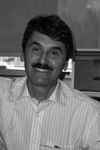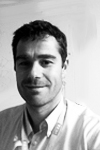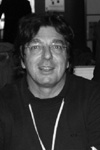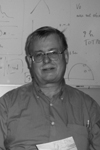advanced applications of fluorescence techniques
july 4-6, 2016 | avellino, italy
Dr. Beniamino Barbieri | ISS, Inc. | President | 1602 Newton Dr. | Champaign, IL 61822 | USA | Tel: 217-359-8681 | beniamino.barbieri@iss.com
Prof. Ranieri Bizzarri | Scuola Normale Superiore | National Enterprise for Nanoscience and Nanotechnology | Piazza dei Cavalieri, 6 | 56100 Pisa | Italy | Tel: +39-050-509-434 | r.bizzarri@sns.it
In 1997 Dr. Ranieri Bizzarri got a M.Sc. in Chemistry with honors as student of Scuola Normale Superiore (SNS) in Pisa. Dr. Bizzarri got his PhD with honors in 2001 with a thesis, "New Polymeric Materials for Tissue Engineering Applications," under the supervision of Prof. Emo Chiellini. As a PhD student, he was a visiting fellow at the University of Paris XII/CNRS and at Cornell University (NY, USA). Then he worked as researcher at Kedrion Biopharmaceuticals and as post-doc at the University of Pisa on a project concerning the production of new nanomaterials for drug delivery applications. In 2003 Dr. Bizzarri won a position as research assistant at SNS until may 2010; he works in NEST laboratory of SNS directed by Prof. Fabio Beltram.
Dr. Bizzarri is co-author of 29 journal articles, two book chapters, and one patent. He is a lecturer at two annual courses at SNS. He has been a speaker at more than 15 international conferences, co-organized a session at the 2008 meeting of the Biophysical Society, and is currently organizing an international meeting entitled "Autofluorescent proteins: the colorful revolution of molecular biology" to be held in Genova, Italy on July 10th.
His early scientific interests encompassed the preparation and engineering of biodegradable polymeric materials for biomedical applications such as protein drug delivery and soft tissue reconstruction. At Cornell University, Dr. Bizzarri became interested in the use of fluorescent probes to visualize intracellular processes. In 2003 he started an intense research activity on nanobiotechnology applied to biomedicine at SNS. He focused mainly on the engineering of new fluorescent probes for in vivo biochemical detection with high spatial-temporal resolution. In his career, he has acquired skills in organic/polymer chemistry, molecular spectroscopy, and confocal microscopy. He has a strong nanobiotechnology background focused on the photophysical properties of matter, self-assembly processes, and nanomedicine.
Dr. Sabato D'Auria | Director of the Institute of Food Science | CNR, Avellino |
Sabato D'Auria is the Director of the Institute of Food Science, CNR, Avellino, Italy.
Dr. D'Auria is a biologist (University of Napoli Federico II), a Medical Geneticist (University of Rome La Sapienza), and a General Pathologist (University of Napoli Federico II).
He has been working at the Center for Fluorescence Spectroscopy, University of Maryland, Baltimore, Maryland, USA, as a Research Associate (1997-1999) and later as a Faculty Member Visiting Associate Professor (2000-2002). Actually, he is a Professor invitée at the Centre INRS - Institut Armand-Frappier, Laval, Quebec, Canada.
The main interest of D'Auria’s laboratory is on understanding the rules underlying the folding of proteins and how their structure is modified by the interaction with other proteins, nucleic acids and small ligand molecules. The acquired knowledge in protein structure is used for the design of innovative biosensors for health, environment, food safety and food quality. The lab is equipped with the state-of-art instrumentation for investigating biological interactions by means of FRET, time-resolved FRET, fluorescence polarization, anisotropy decays, fluorescence correlation spectroscopy for single molecule detection, surface plasmon resonance, circular dichroism in the far- and near-UV regions, stopped-flow methodologies, and metal enhanced fluorescence. The lab is also active in the use of fluorescence to quantify structural features of biological molecules even at nano-scale, and, consequently, to design advanced optical biochips, Lab-on-Chip, or simple disposable biosensors for analyses of high social interest (POCT). Several national and international patents on new diagnostic techniques have been issued to D'Auria’s Lab.
Prof. Alberto Diaspro | University of Genova | Department of Physics | Nanoscopy and NIC@IIT | 16146 Genova | Italy | Tel: +39-0103536426 | diaspro@fisica.unige.it
Alberto Diaspro is Director of the Department of Nanophysics at the Istituto Italiano di Tecnologia (IIT), Deputy Director of IIT, Chair of the Nikon Imaging Center at IIT (www.nic.iit.it). Diaspro is Professor of Applied Physics at the Department of Physics of University of Genova and supervisor for the Ph.D. Courses in the Bioengineering and Robotics and Physics programs at the University of Genova within the IIT program. He was President of OWLS (Optics with Life Sciences), EBSA (European Biophysical Societies Association) and Appointed Vice President of ICO (Interational Commission of Optics). Diaspro is a founder of the Nanoscale Biophysics Subgroup of the Biophysical Society. During the 90s he carried out part of his research activity at Drexel University (PA, USA), Universidad Autonoma de Madrid (Spain) and Czech Academy of Sciences (Czech Republic). He also coordinated a research program (2004-2012) at IFOM-IEO Campus in Milano on Biomedical Research and is currently associated with the Institute of Biophysics at the National Research Council (CNR)(since 2006). He founded LAMBS (Laboratory for Advanced Microscopy, Bioimaging and Spectroscopy) in 2003. Diaspro realized a hybrid artificial “nanobiorobot” within the EU and national Research Projects (2000-2005), and designed and realized the first Italian multiphoton microscope within a research grant of the National Institute of Physics of Matter (1999). He directed the design and realization of the first Italian nanoscopy architecture at the Neuroscience and Brain Technologies Department of IIT (2008).
At present, Alberto Diaspro coordinates the Nanobiophotonics IIT research program and is the PI of the Nanoscopy research team. He is coordinator of several EU and national research programs, and published more than 300 international peer-reviewed papers with 7000 citations, H=38 (source Google Scholar). He is Editor in Chief of the Wiley international Journal Microscopy Research and Technique and an active member of international editorial boards and societies (SIOF, SIF, SISM, SIBPA, BS, EBSA, OWLS, IEEE, SPIE, OSA). Diaspro is an IEEE senior member and SPIE fellow. He received the Emily M. Gray Award in 2014, and is the president of the Scientific Council of the Festival of Science.
Prof. Zygmunt Gryczynski | University of North Texas | Dept. of Molecular Biology and Immunology | 3500 Camp Bowie Blvd. | Fort Worth, TX 76107 | USA | Tel: 808-956-5034 | zgryczyn@hsc.unt.edu
Dr. Zygmunt Gryczynski received an M.S. in experimental physics in 1982 from the University of Gdansk and a Ph.D. in spectroscopy in 1987 working on the basic spectroscopic studies of isotropic and oriented systems of organic molecules. In 1991 he become a Research Assistant Professor in the Department of Biochemistry and Molecular Biology at the University of Maryland, and from 1998-2005 he was an Assistant Director in the Center for Fluorescence Spectroscopy at the University of Maryland. Since 2005 he is a Professor of Molecular Biology and Immunology at the University of North Texas Health Science Center at Fort Worth, Texas. In 2006, with the support from Emerging Technology Funds (ETF) of Texas and his colleagues, he established a Center for Commercialization of Fluorescence Technologies (CCFT).
His early work at the University of Maryland was focused on ultrafast time-resolved fluorescence spectroscopy, intrinsic fluorescence of hemoproteins as well as the thermodynamics of ligand binding and the allosteric mechanism of O2 binding in hemoproteins. He has pioneered the use of multi-photon excitation and light quenching in time-resolved fluorescence spectroscopy. His focus has been on applications of fluorescence spectroscopy to study biological systems using time-resolved fluorescence, anisotropy, and FRET. He also pioneered novel fluorescence sensing methods for biomedical applications in tissue and blood. His interest includes modern optical imaging methods with a focus on fluorescence microscopy. For the last six years his interests expanded to nanotechnology and applications of novel plasmonic effects induced by light in metallic nanostructures to fluorescence spectroscopy. He pioneered metal enhanced fluorescence and surface plasmons coupled emission (SPCE) phenomena for biomedical and diagnostics applications. His current focus is to explore quantum-level interactions to study the dynamics of biophysical and biochemical processes at the molecular level. He is an author of over 150 peer-review publications and eight book chapters.
Prof. Dr. Martin vandeVen | Hasselt University and School of Life Sciences | Transnationale Universiteit Limburg | Biomedical Research Institute | Agoralaan, Bldg. C., | B-3590-Diepenbeek | Belgium | Tel: +31-(0)11-269233/martin.vandeven@uhasselt.be | martin.vandeven@uhasselt.be
Martin vandeVen is a guest professor associated with the Biomedical Research Institute of Hasselt University and the School of Life Sciences, transnational University Limburg. Martin vandeVen obtained his Ph.D. from Utrecht University, The Netherlands in 1983, studying lipid systems using optical methods at the Biophysics department under Prof. Levine. Subsequently, he worked at Leiden University, The Netherlands, in the laboratory of Prof. Duysens on picosecond phenomena in bacterial photosynthetic systems and with Prof. Brand of John Hopkins University on the fluorescence emission from proteins. He then held a research associate position focused on instrumentation development under the guidance of Prof. Gratton at the Laboratory for Fluorescence Dynamics then located at the University of Illinois in Urbana-Champaign and now at the University of California at Irvine. At Hasselt University he continues to research confocal microscopy techniques such as FCS, FRAP and RICS on cells and tissues, auto-immune brain diseases such as multiple sclerosis and interdisciplinary development of diamond-film-based biosensors.







